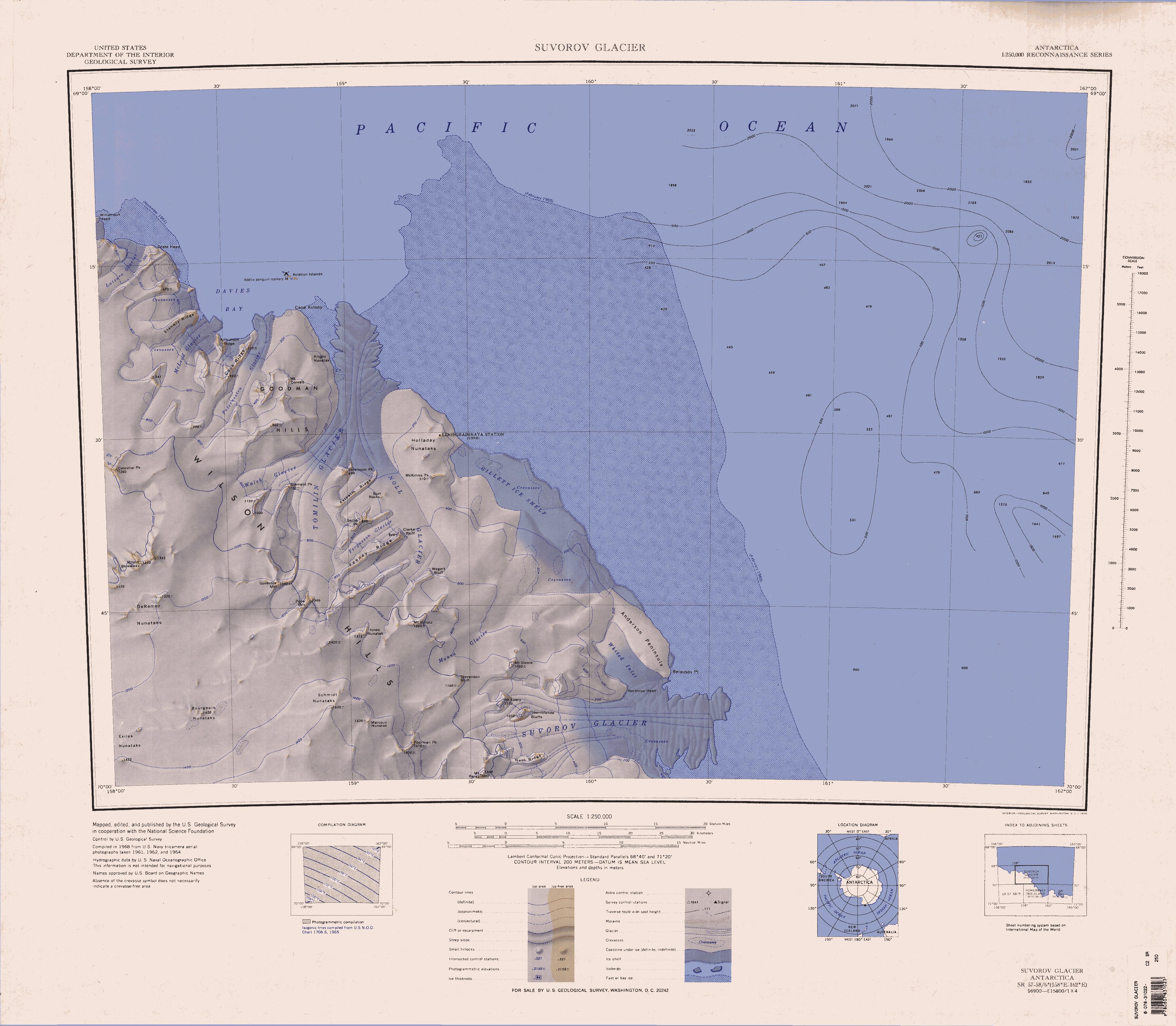Suvorov Glacier on:
[Wikipedia]
[Google]
[Amazon]
Suvorov Glacier () is a glacier, wide, flowing east from the Wilson Hills and discharging into the sea south of Northrup Head and Belousov Point.
The glacier was mapped by the

Soviet Antarctic Expedition
The Soviet Antarctic Expedition (SAE or SovAE) (, ''Sovetskaya antarkticheskaya ekspeditsiya'') was part of the Arctic and Antarctic Research Institute of the Soviet Committee on Antarctic Research of the Academy of Sciences of the USSR. It was ...
, 1958, and named after V.S. Suvorov, Soviet mechanic who perished in the Arctic.
Location
The Suvorov Glacier forms in the Wilson Hills and flows east to theSouthern Ocean
The Southern Ocean, also known as the Antarctic Ocean, comprises the southernmost waters of the world ocean, generally taken to be south of 60th parallel south, 60° S latitude and encircling Antarctica. With a size of , it is the seco ...
.
Mount Steele
Mount Steele is the fifth-highest mountain in Canada and either the tenth- or eleventh-highest peak in North America. Its exact elevation is uncertain. Commonly-quoted figures are and . A lower southeast peak of Mt. Steele stands at .
It was n ...
, Mount Ellery, the Hornblende Bluffs, Heth Ridge and Mount Send are to the west.
To the north, near its mouth, it passes Northrup Head, Whited Inlet and Belousov Point on the Anderson Peninsula.
Features

Hornblende Bluffs
. Prominent bluffs that rise to high, located southeast of Mount Ellery and near the head of Suvorov Glacier, in Wilson Hills. So named by the northern party ofNew Zealand Geological Survey Antarctic Expedition
The New Zealand Geological Survey Antarctic Expedition (NZGSAE) describes a series of scientific explorations of the continent Antarctica. The expeditions were notably active throughout the 1950s and 1960s.
Features named by the expeditions 19 ...
(NZGSAE), 1963-64, who found the rock here contains the mineral hornblende.
Heth Ridge
. A ridge long, located south of Hornblende Bluffs and near the head of Suvorov Glacier, in the Wilson Hills. Mapped byUnited States Geological Survey
The United States Geological Survey (USGS), founded as the Geological Survey, is an agency of the U.S. Department of the Interior whose work spans the disciplines of biology, geography, geology, and hydrology. The agency was founded on Mar ...
(USGS) from surveys and United States Navy air photos, 1960-63.
Named by United States Advisory Committee on Antarctic Names
The Advisory Committee on Antarctic Names (ACAN or US-ACAN) is an advisory committee of the United States Board on Geographic Names responsible for recommending commemorative names for features in Antarctica.
History
The committee was established ...
(US-ACAN) for Samuel R. Heth, United States Antarctic Research Program
The United States Antarctic Program (or USAP; formerly known as the United States Antarctic Research Program or USARP and the United States Antarctic Service or USAS) is an organization of the United States government which has a presence in the ...
(USARP) biologist at Hallett Station
Cape Hallett is a snow-free area (Antarctic oasis) on the northern tip of the Hallett Peninsula on the Ross Sea coast of Victoria Land, East Antarctica. Cape Adare lies to the north.
History
In 1956, during Operation Deep Freeze II, was dama ...
, 1968-69.
Northrup Head
. An ice-covered headland on the north side of Suvorov Glacier. The headland, a coastal extension of the Wilson Hills, stands west-southwest of Belousov Point. Mapped by USGS from surveys and United States Navy air photos, 1960-63. Named by US-ACAN for David A. Northrup, ATN2, United States Navy, Aviation Electronics Technician with Squadron VX-6 at McMurdo Station, 1967.Whited Inlet
. An ice-filled inlet along the coast between Northrup Head and Anderson Peninsula. Mapped by USGS from surveys and United States Navy air photos, 1960-63. Named by US-ACAN for Master Chief Quartermaster Robert J. Whited, United States Navy, Leading Chief for the staff and a member of Operations Division responsible for maintaining and updating charts for Task Force 43 during Operation Deep Freeze 1968 and 1969.Anderson Peninsula
. Low ice-covered peninsula, long, terminating in Belousov Point. The feature lies between Gillett Ice Shelf and Suvorov Glacier on the coastal margin of the Wilson Hills. Mapped by USGS from surveys and United States Navy air photos, 1960-64. Named by US-ACAN for Lieutenant (later Captain) Richard E. Anderson, CEC, United States Navy, base public works officer at McMurdo Sound during Operation Deep Freeze I and II. He wintered over in the McMurdo area during the latter operation, 1957.References
Sources
* * * {{Authority control Glaciers of Pennell Coast Glaciers of Oates Land